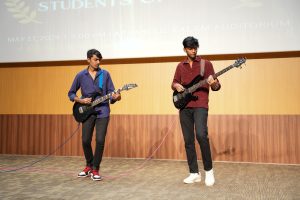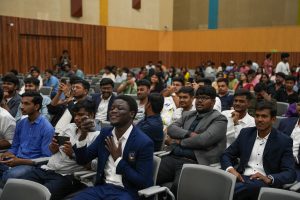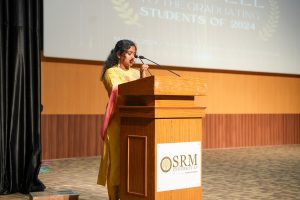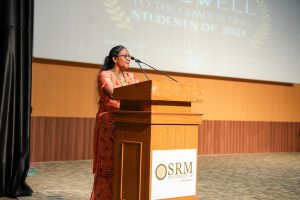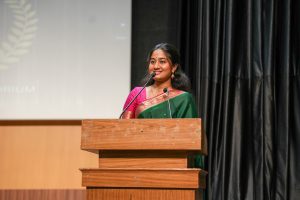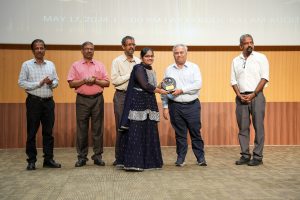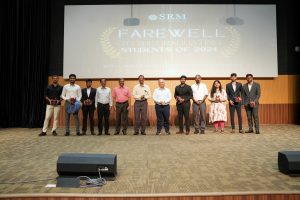All Management News
- SRM AP and MGIT: An Alliance Fostering Research Advancements in Drone Technology May 30, 2024

The Centre for Drone Technology, SRM University-AP, has signed an MoU with MGIT Co. Ltd, South Korea, on May 09, 2024, to facilitate research, academic, and scientific knowledge exchange in Drone technology. The agreement to spearhead research and technology developments in drone applications was signed by Dr R Premkumar, Registrar of SRM University-AP, and Mr Jeong Woo-Chul, CEO of MGIT Co. Ltd, in the presence of Mr Yun Cheol-Hun, Assistant Manager, MGIT Co. Ltd, and Dr Pranav RT Peddinti, Assistant Professor, Dept. Civil Engineering.
This collaboration signifies a major leap forward in harnessing the power of cutting-edge drone technology to address real-world challenges. The MOU facilitates the university to have experts from MGIT deliver seminars, workshops, symposia, etc., to the students and faculty of SRM AP on drone technology, its allied technologies and its applications. Undergraduate and postgraduate students and doctoral scholars of the university will also have the opportunity to be part of collaborative research projects and internships that would hugely benefit them in enhancing their awareness of drone technology.
The scope of the MOU also extends to collaboration with MGIT for national and international research funding, eligible researchers from MGIT to enrol in various courses at SRM AP, and extending the university’s academic, research and technical facilities such as laboratories, library, etc to MGIT team for research purposes.
The MOU between SRM AP and MGIT explores innovative solutions, pushes the boundaries of possibility, and revolutionises the future of drone technology.
Continue reading → - Dr Nilakantha Meher May 30, 2024
- Examining Karnataka’s Mandate for Signboards: Paper by Dr Vineeth Thomas May 30, 2024
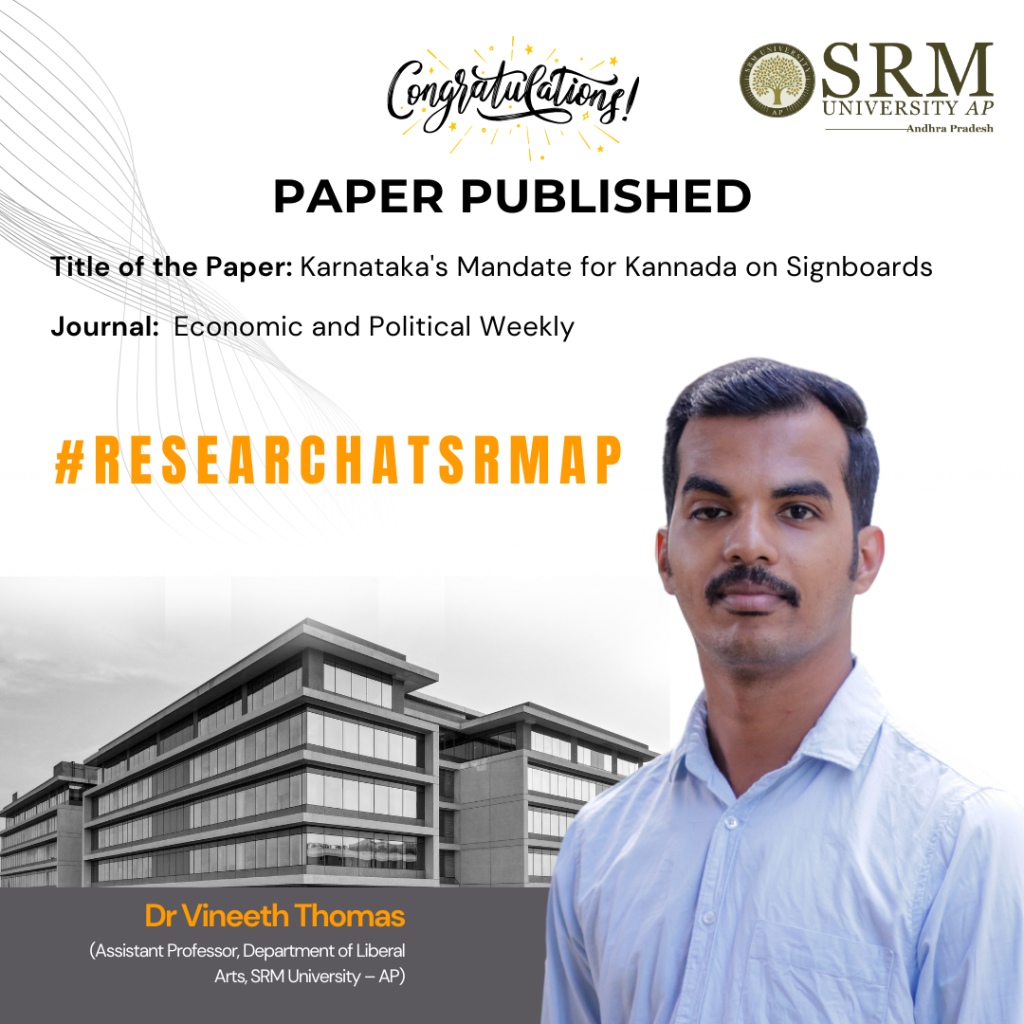
In a research paper published in Economic and Political Weekly, Dr Vineeth Thomas, an Assistant Professor at the Department of Liberal Arts, delves into the socio-political and economic implications of the “Karnataka’s Mandate for Kannada on Signboards” amendment. The article highlights the social and cultural significance of the amendment and raises awareness about the potential economic challenges it may pose. This insightful paper not only makes for an engaging read but also serves as a valuable resource for policymakers and politicians, bringing attention to the practical and social implications of the amendment.
Abstract
The Kannada Language Comprehensive Development (Amendment) Bill, 2024, ratified by the Karnataka Legislative Assembly and Legislative Council, stands as a legislative landmark with profound implications. This commentary critically analyses the socio-economic-political implications, unravelling the intricate web of influences that the Kannada Language Comprehensive Development Bill introduces within the diverse and dynamic landscape of Karnataka.
Citation
Roshmi Antony, Vineeth Thomas, Lulubala Nayak (2024)-, Karnataka’s Mandate for Kannada on Signboards, Economic and Political Weekly, ISSN (Online) – 2349-8846 (SCOPUS /ABDC Indexed)
Continue reading → - SRM Foundation Establish a Free Tuition Centre at Nidamarru May 30, 2024
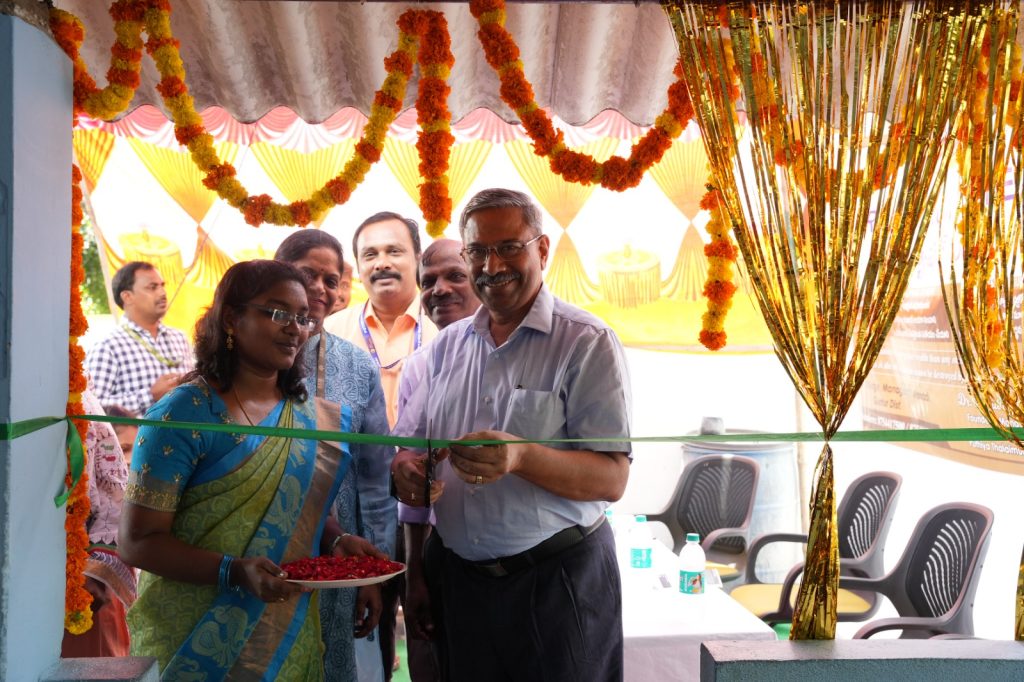
A free tuition centre was established in the Nidamarru village on Wednesday under the auspices of SRM Foundation. Dr R Premkumar, Registrar of SRM University-AP and Mrs Revathi Balakrishnan, Associate Director – Directorate of Student Affairs, jointly inaugurated the centre. Dr Premkumar addressed the students and their parents on this occasion, stating that “SRM Foundation of SRM University (Chennai), which is internationally renowned as a leading educational institution in teaching and research, is also active in social service schemes and programs in the states of Tamil Nadu and Andhra Pradesh. This tuition centre is a testament to the Foundation’s philosophy of development for the societal cause.”
The Foundation’s spokesperson, Mr Suresh Kannan, stated that the Foundation set up the first rural tuition centre to provide free education to rural students in Tamil Nadu. SRM AP Media Public Relations Manager Mr Venugopal Gangisetty further remarked that 22 tuition centres have been established in Tamil Nadu state, with 570 students being taught the curriculum. This is the first free tuition centre to be established in Andhra Pradesh.
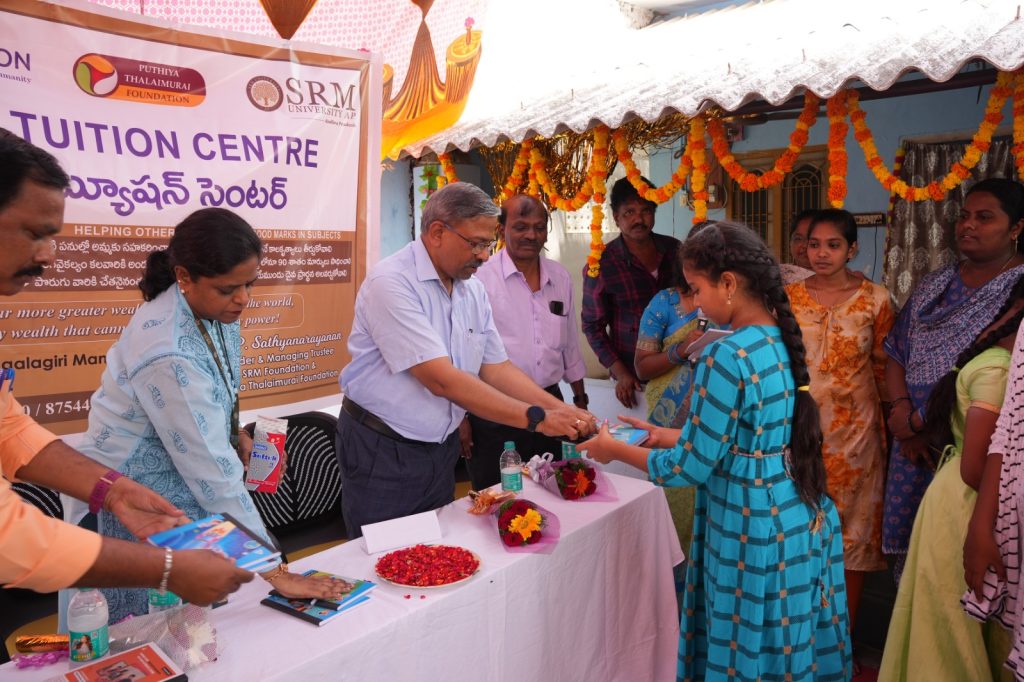
Mr Elamaran, Senior Consultant of Puthiyathalaimurai Foundation, said that students studying in sixth to tenth standard from economically backward families will be taught free of charge at the tuition centre. Many students of the villages and their parents were overjoyed as this was a remarkable hope to guarantee quality education and support for their children. Ms Prathipati Sushma, a teacher at the tuition centre, thanked SRM Foundation for setting up the first tuition centre in Nidamarru and giving her the opportunity to teach. Sweets and notebooks were distributed to the students after the program. SRM AP Chief Liaison Officer Mr Poolla Ramesh Kumar, Assistant Manager Mr Ramachandra Reddy and the residents of Nidamarru village participated in this program.
Continue reading → - SRM University-AP Forges Partnership with AIMA May 30, 2024
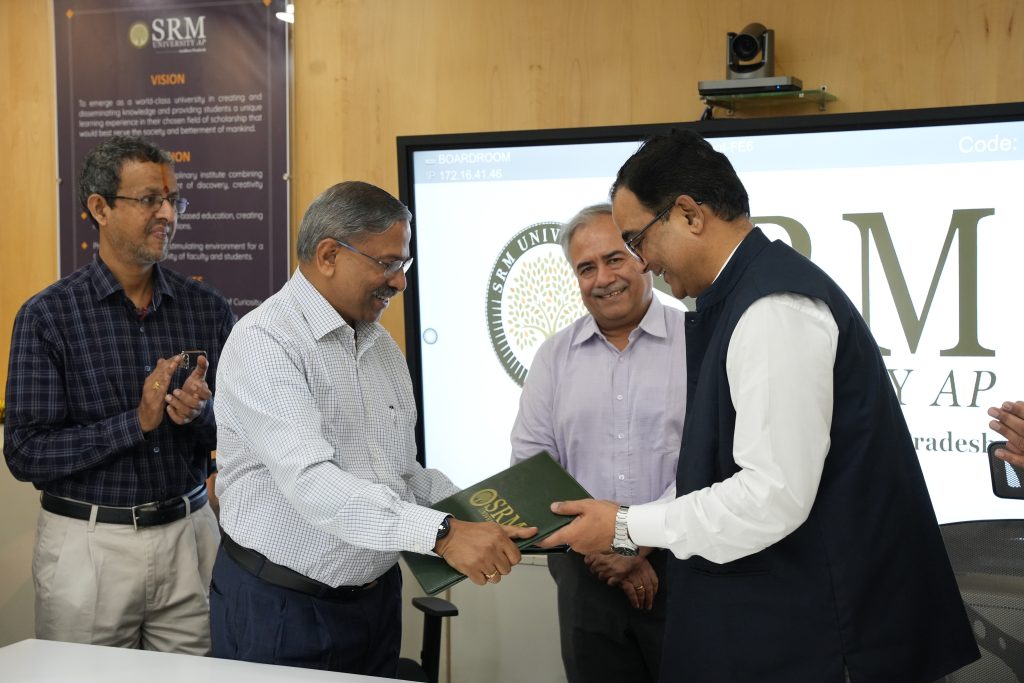
In a historic moment, Prof. Rohit Singh, Director of the Centre for Management Education at the All India Management Association (AIMA), and Dr R Premkumar, Registrar of SRM University-AP, signed a memorandum of understanding (MoU). This MoU aims to foster collaboration between the two institutions and introduce a part-time PhD programme for working professionals.
The signing ceremony was attended by distinguished personalities including Dr Ganesh Singh, Professor and Programme Director at the Centre for Management Education; Prof. Manoj K Arora, Vice Chancellor of SRM AP; Prof. Bharadwaj Sivakumaran, Dean of Paari School of Business; Prof. Ranjit Thapa, Dean of Research; Dr Vinayak Kalluri, Dean of Academic Affairs & Controller of Examinations; Dr Maheshwar Dwivedy, Associate Dean of Practice School & Associate Professor; Dr Mahesh Kumar Ravva, Assistant Dean of Research; Dr Satyanarayana Duvvuri, Professor of Practice; Dr CA Mahalakshmi Mudliar, Associate Professor and Head of the Department of Management; Dr A Lakshmana Rao, Associate Professor and Head of the Department of Commerce; and Dr Lalita Mohan Mohapatra, Assistant Professor, along with other faculty members and students.
To date, more than 250 working professionals have earned their PhDs through AIMA. The institution also boasts an illustrious alumni network employed in leading companies such as Samsung, Schneider Electric, Accenture, Amazon, and Tata.
In his address, Vice Chancellor Prof. Manoj K Arora underscored the importance of a supportive research environment and the critical role of the student-guide relationship. Prof. Arora also insisted that the faculty undergo a specialised programme on “how to effectively guide a PhD.” Dr Rohit Singh, Director of AIMA, elaborated on the strategic significance in the broader educational landscape, especially for working professionals.
Members of the academic leadership, faculty, and PhD scholars joined together to congratulate the varsity on its initiative to shake hands with AIMA.
Continue reading →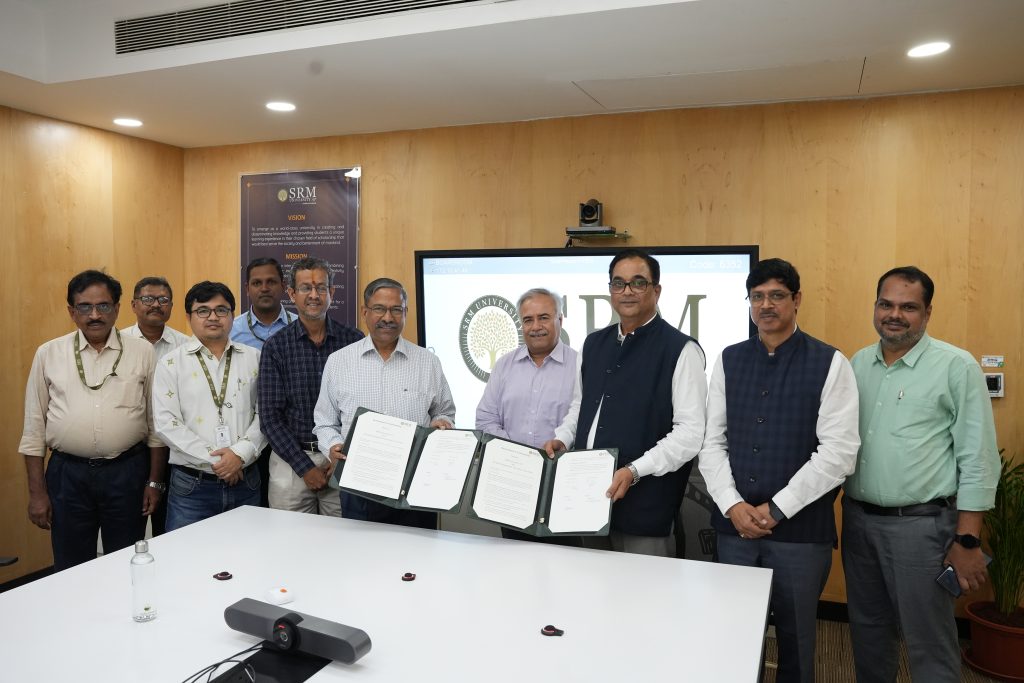
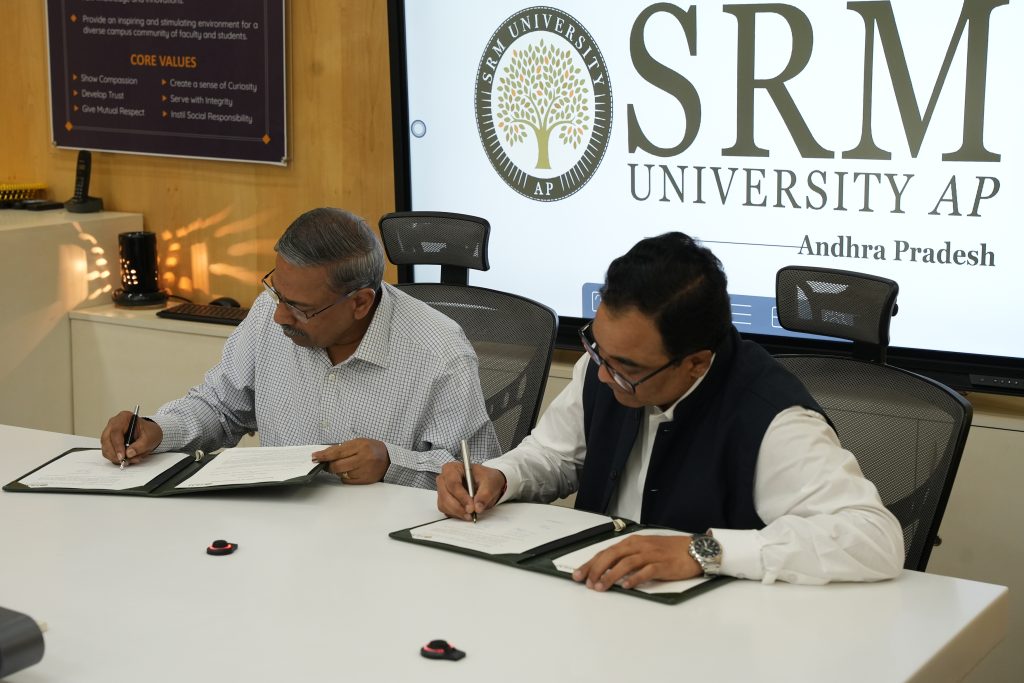
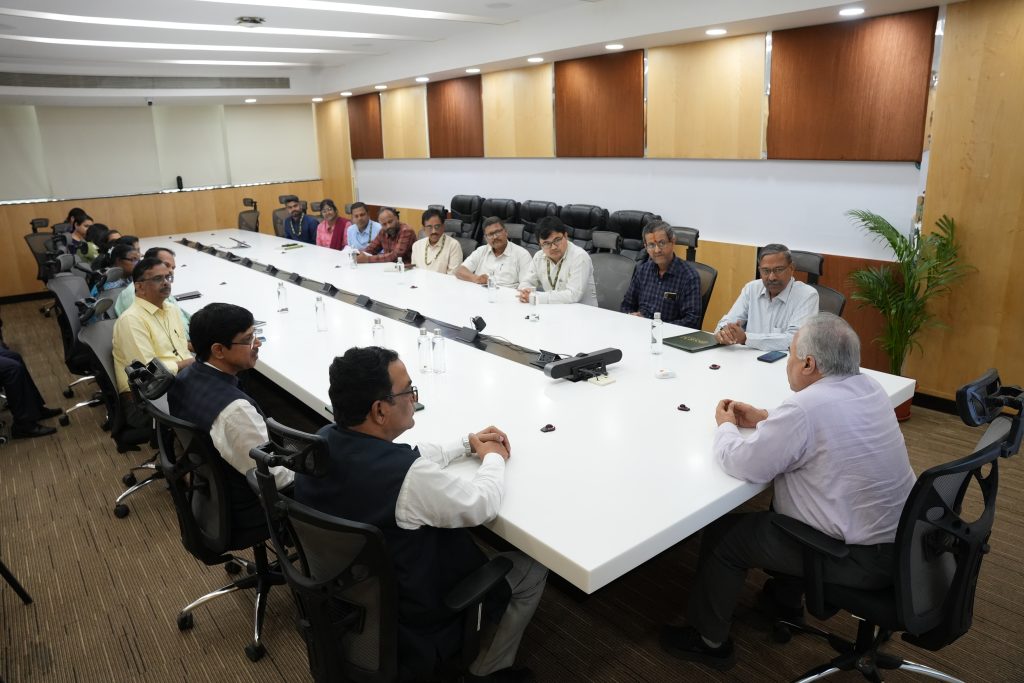
- SRM Foundation Establish a Free Tuition Centre at Nidamarru May 30, 2024
Deccan Chronicle
Continue reading →
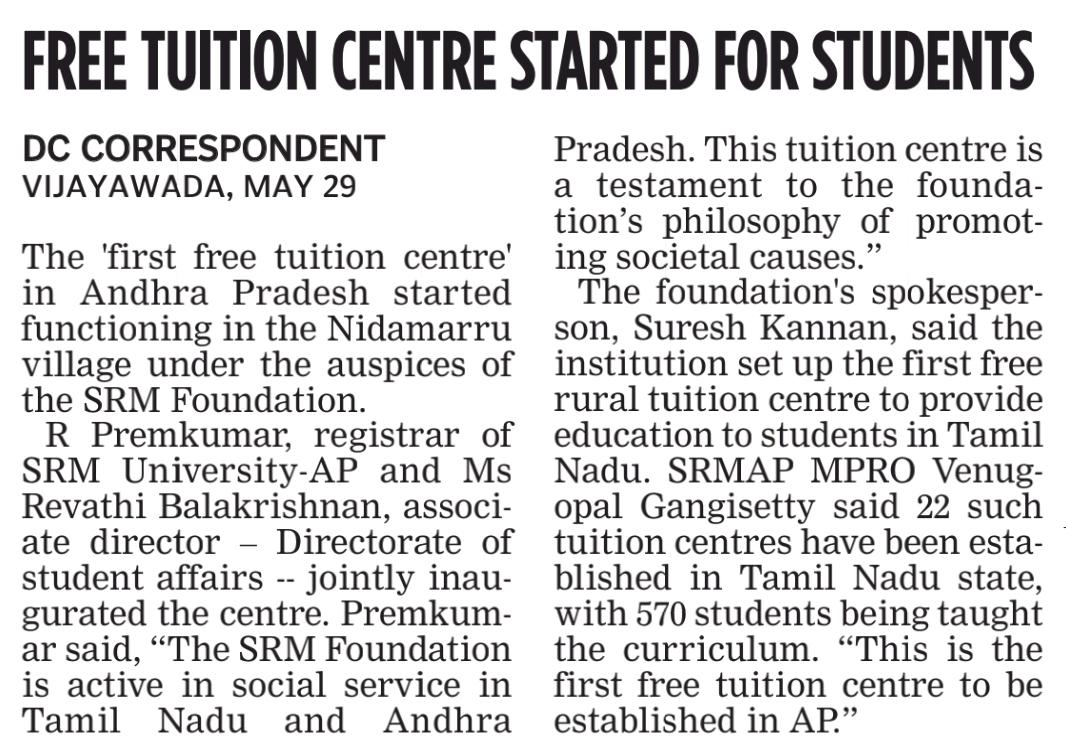
The Hans India
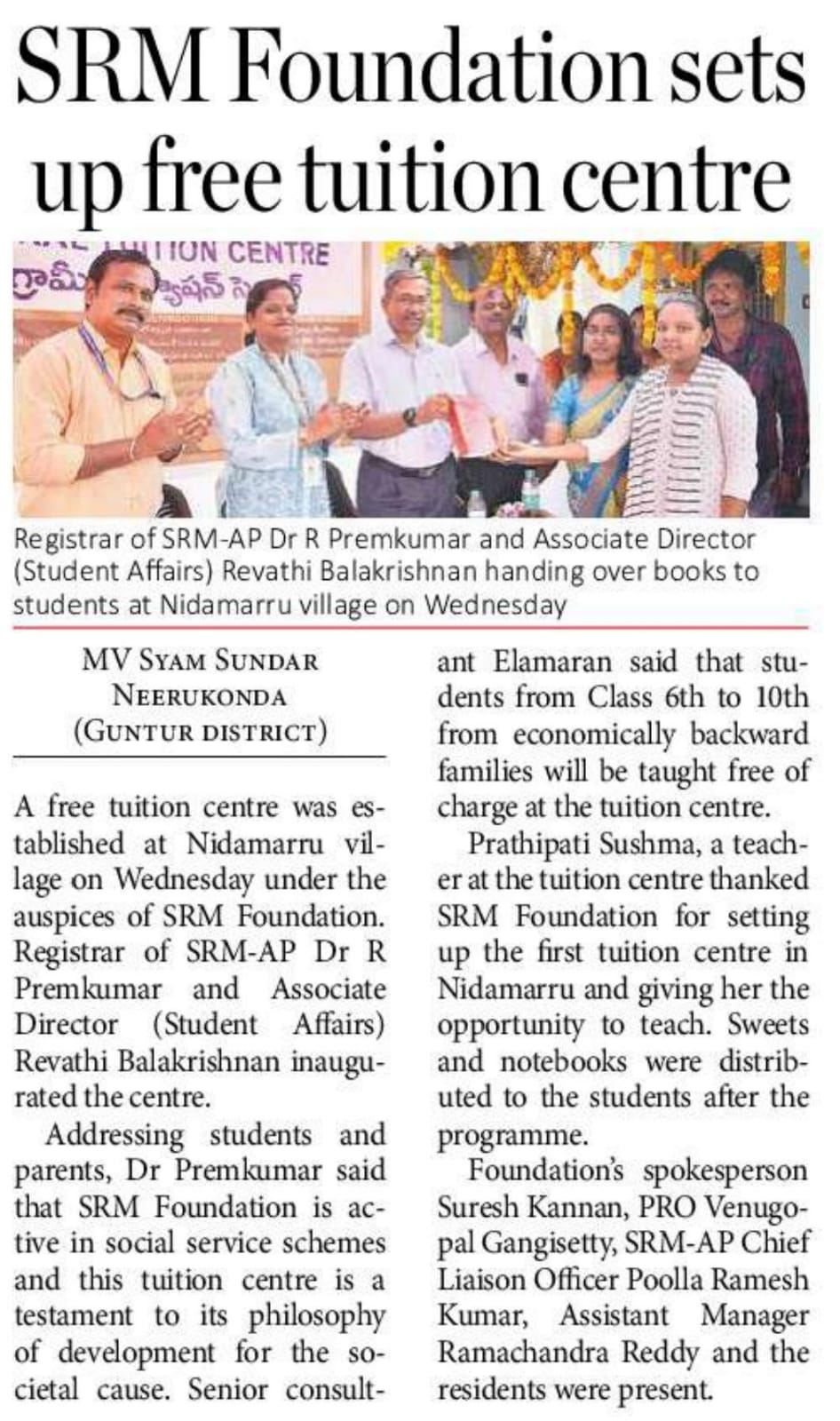
The New Indian Express
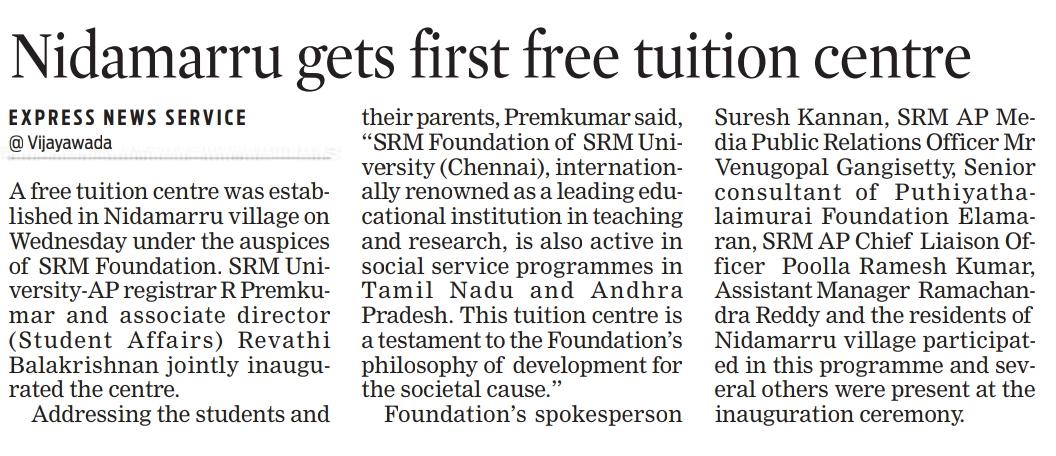
The Pioneer
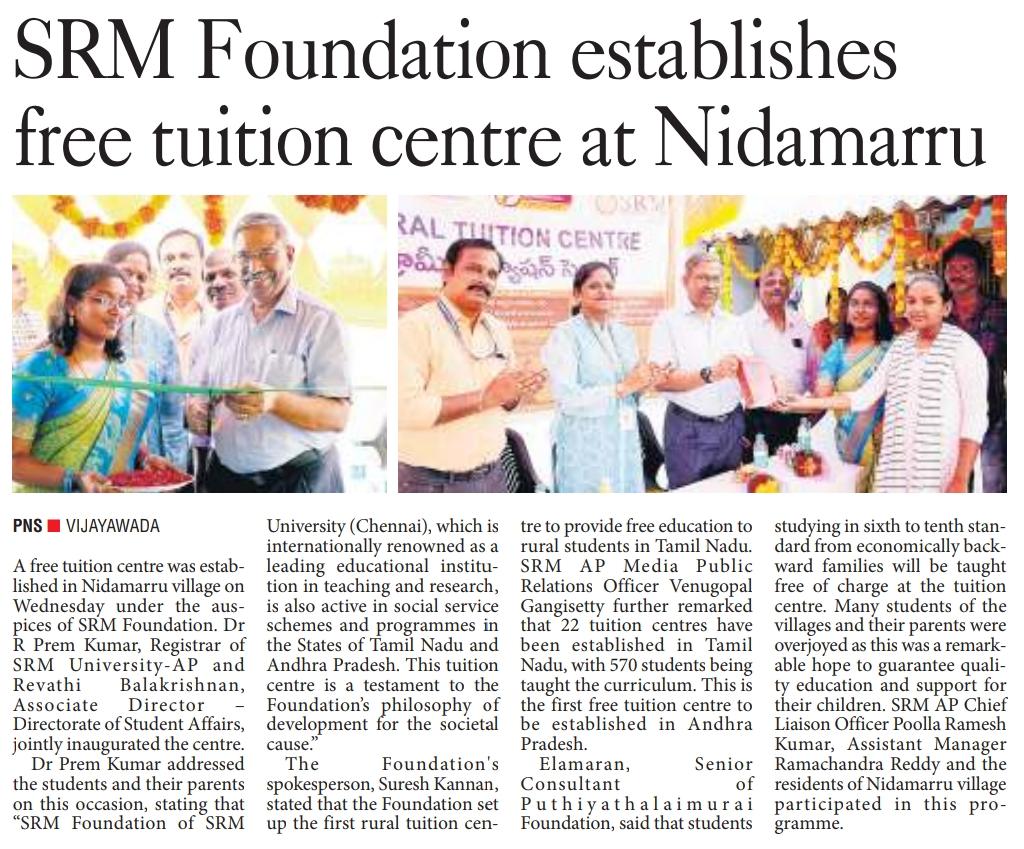
Telugu Patrika
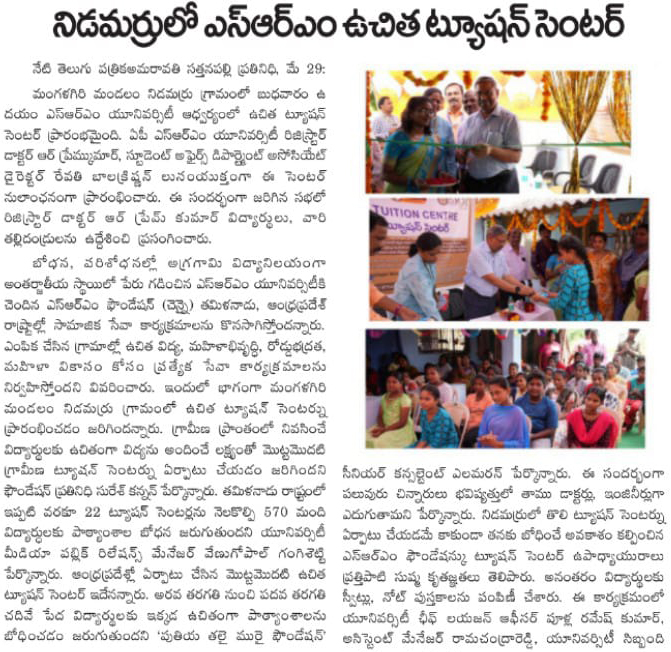
Eenadu
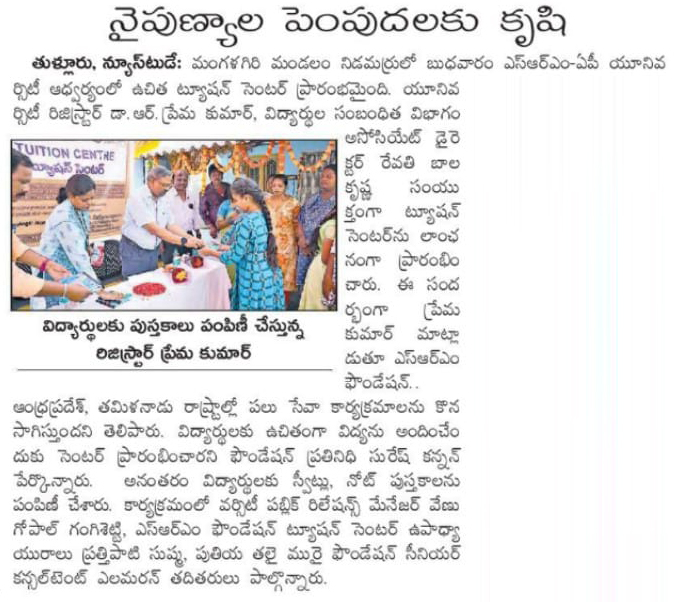
Andhra Patrika
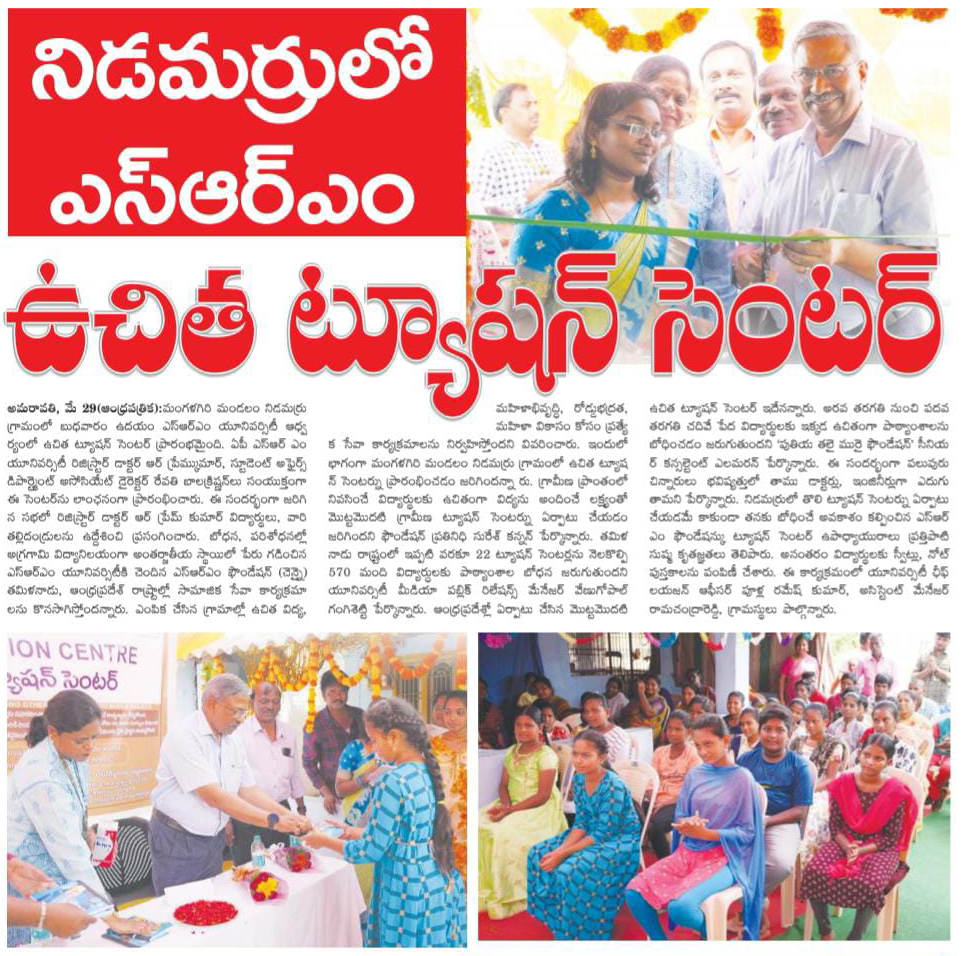
Andhra Prabha
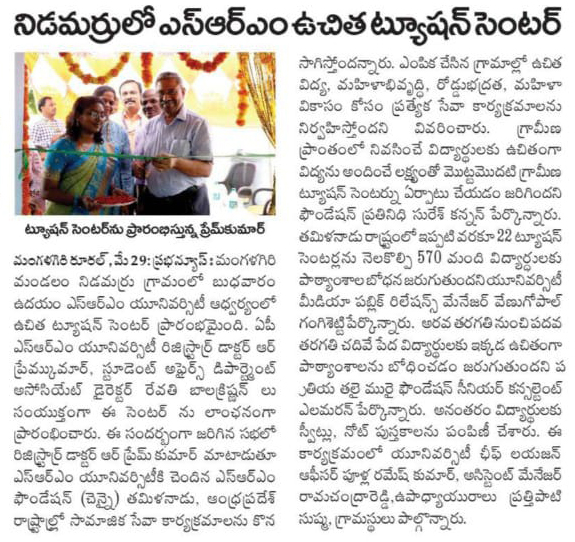
Vartha
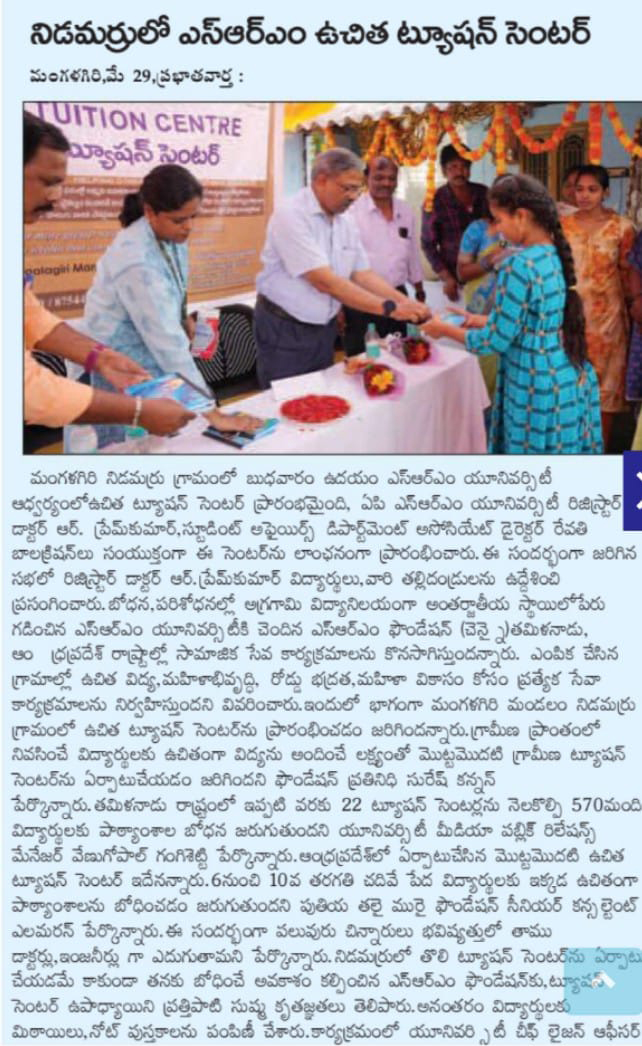
Visalaandhra
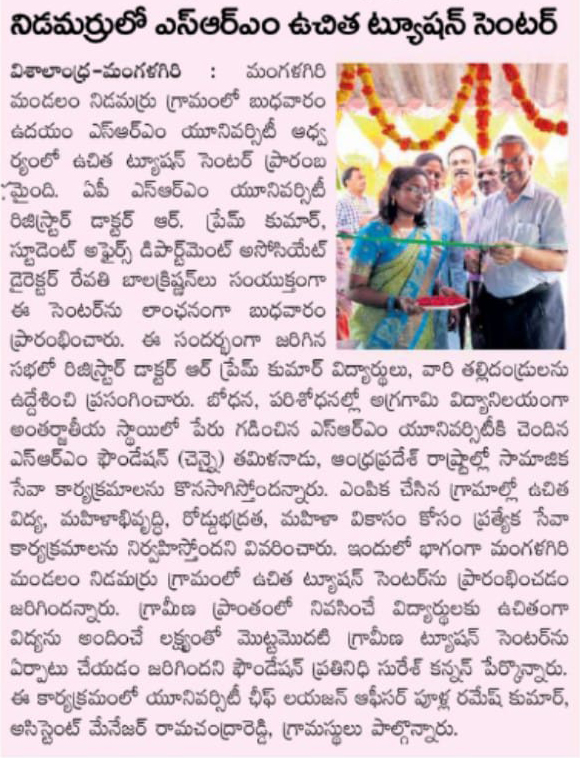
Palana News Daily
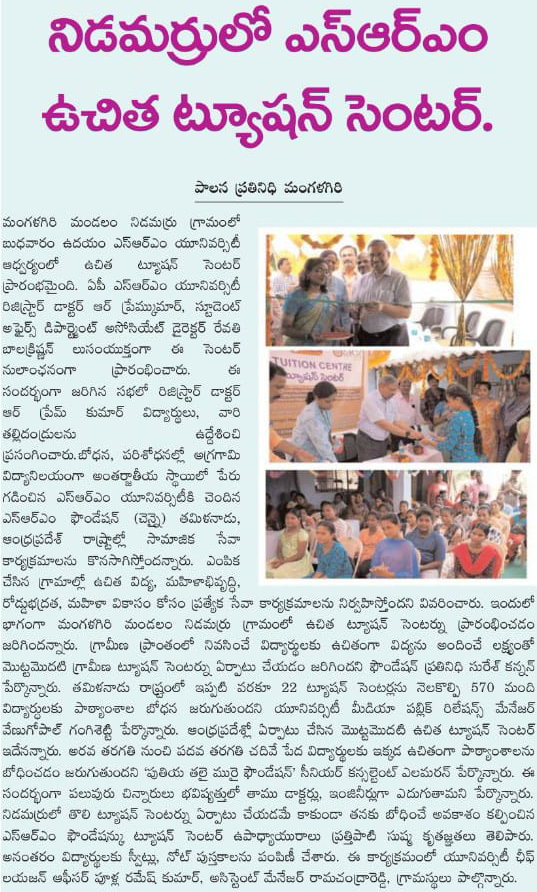
- Faculties Publish an Insightful Article on Political Manifestos and Labor Class May 29, 2024
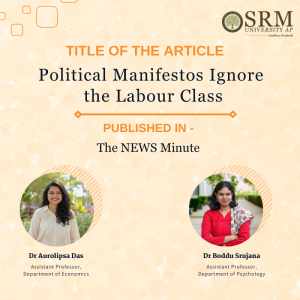 In a thought-provoking article titled “Political Manifestos Ignore the Labor Class,” Dr Aurolipsa Das and Dr Srujana Boddu, Assistant Professors from the Department of Economics, shed light on a critical issue that often goes unnoticed during election seasons. Their research delves into the disconnect between political promises and the ground realities faced by the labour class.
In a thought-provoking article titled “Political Manifestos Ignore the Labor Class,” Dr Aurolipsa Das and Dr Srujana Boddu, Assistant Professors from the Department of Economics, shed light on a critical issue that often goes unnoticed during election seasons. Their research delves into the disconnect between political promises and the ground realities faced by the labour class.They critically examine the shortcomings of political manifestos, highlighting how they often overlook the interests and needs of the labour class. As India heads into another election cycle, Dr Aurolipsa Das and Dr. Srujana’s article serves as a wake-up call for policymakers. To bridge the gap between political promises and ground-level impact, evidence-based policies that prioritise the labor class are essential. It is time for political parties to move beyond rhetoric and take concrete steps toward meaningful progress.
Read the full article by clicking on this link to gain deeper insights into this crucial topic.
Continue reading → - SRM University-AP Signs an MOU with IGCAR for Cutting-edge Biomedical Research May 29, 2024
The Hindu
Continue reading →
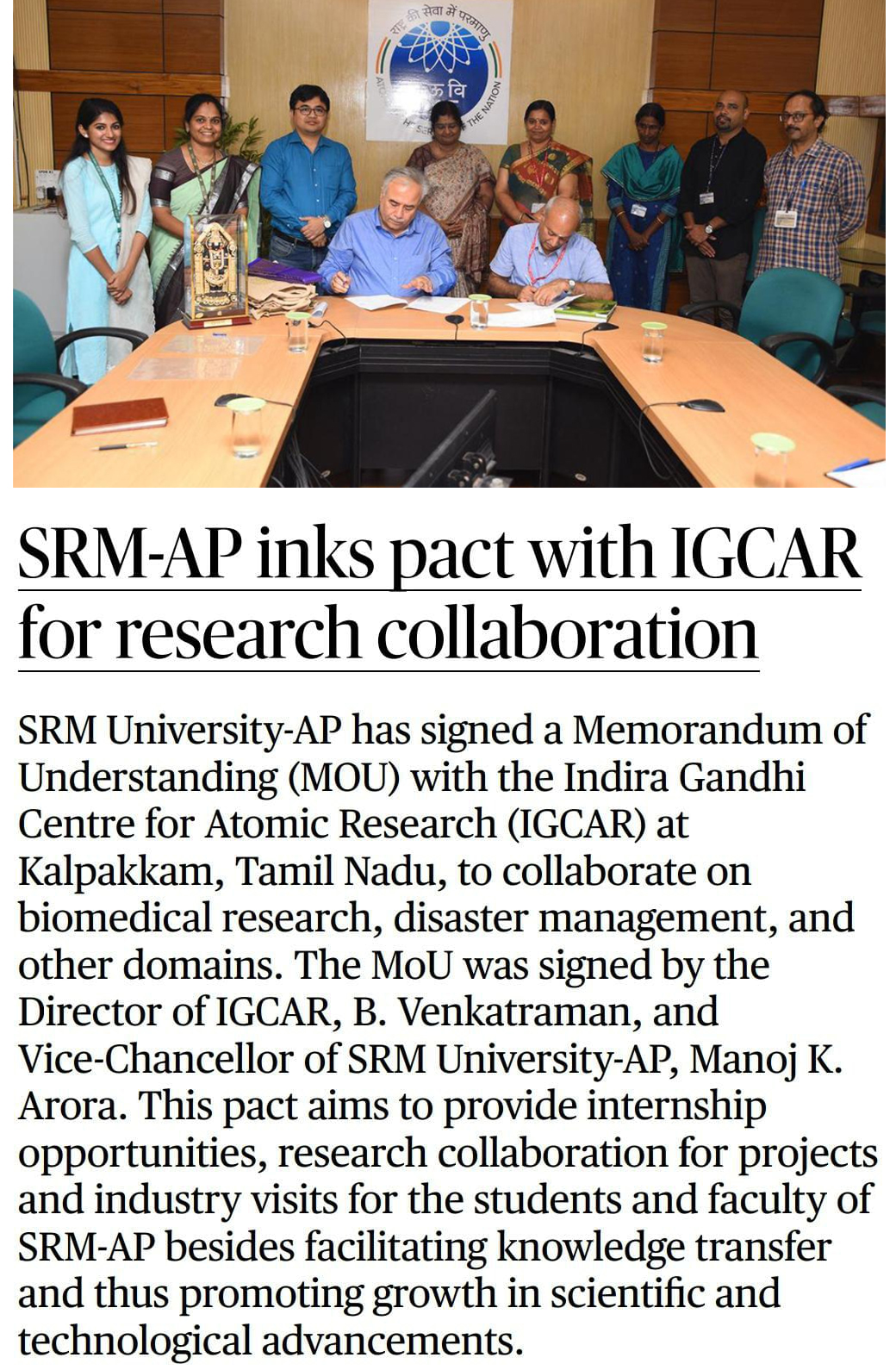
Deccan Chronicle
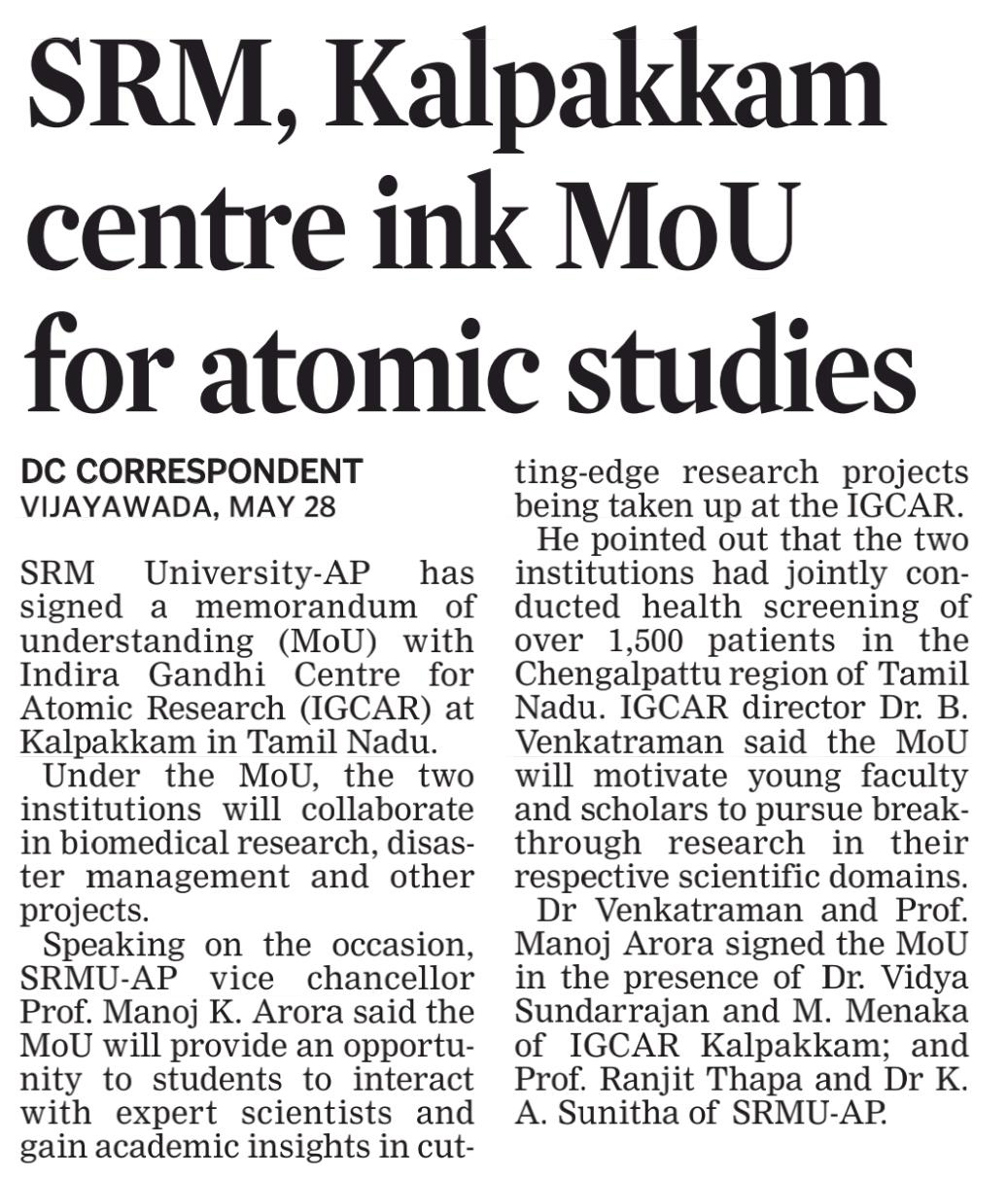
The New Indian Express
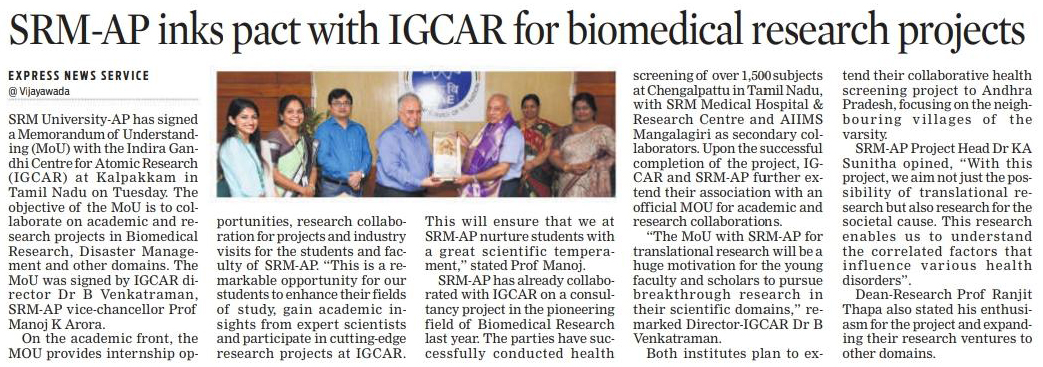
The Hans India
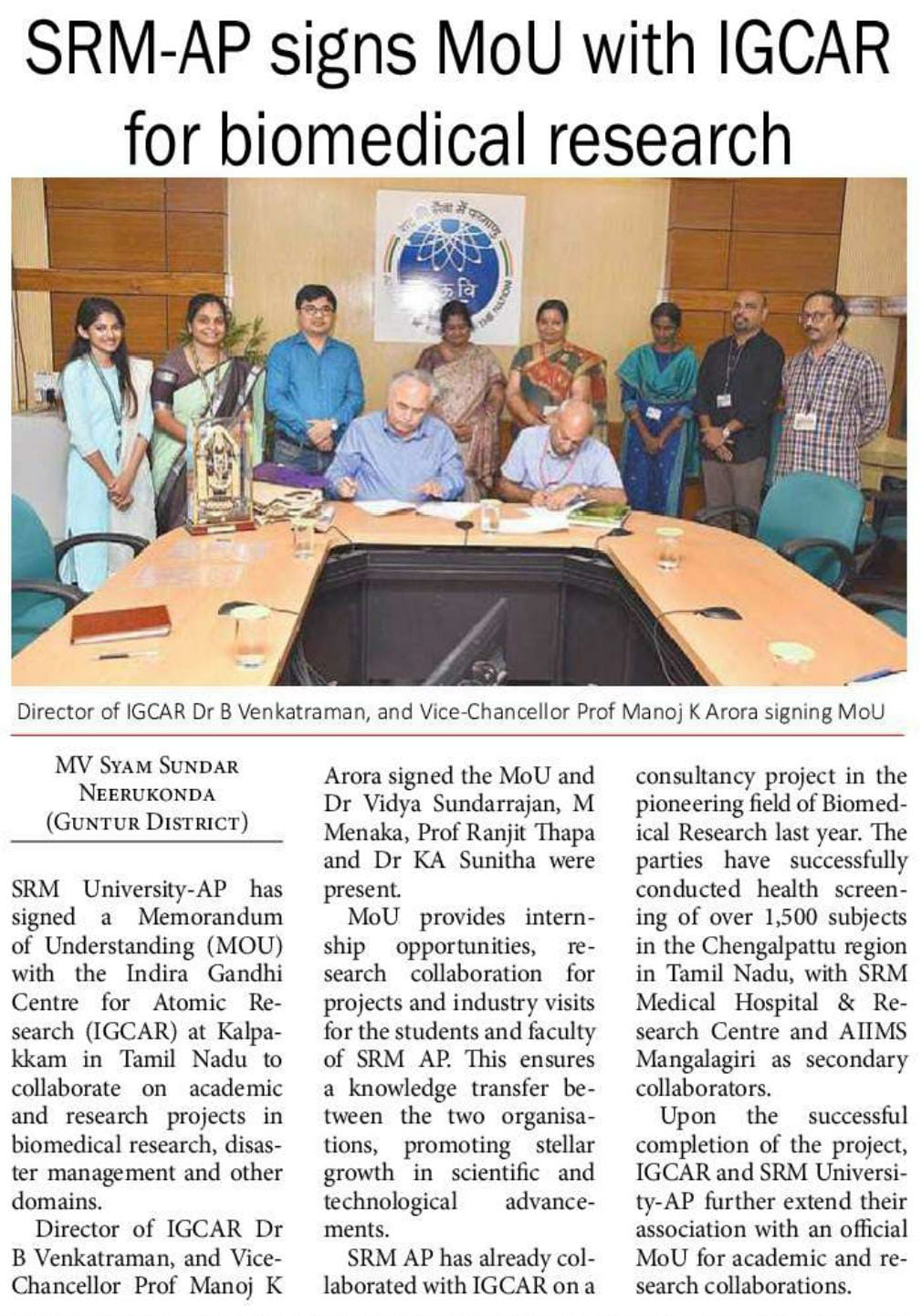
The Pioneer
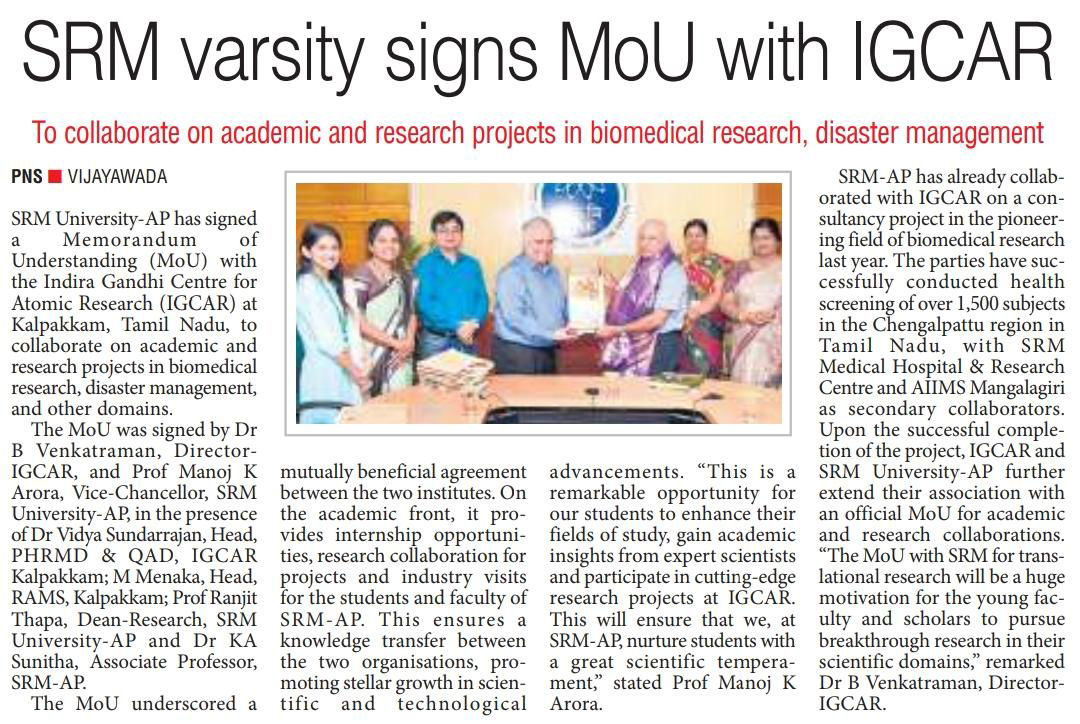
Eenadu
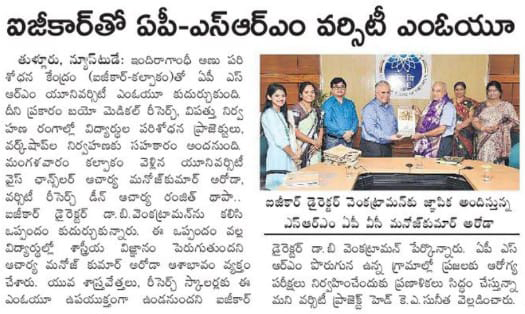
Andhra Patrika
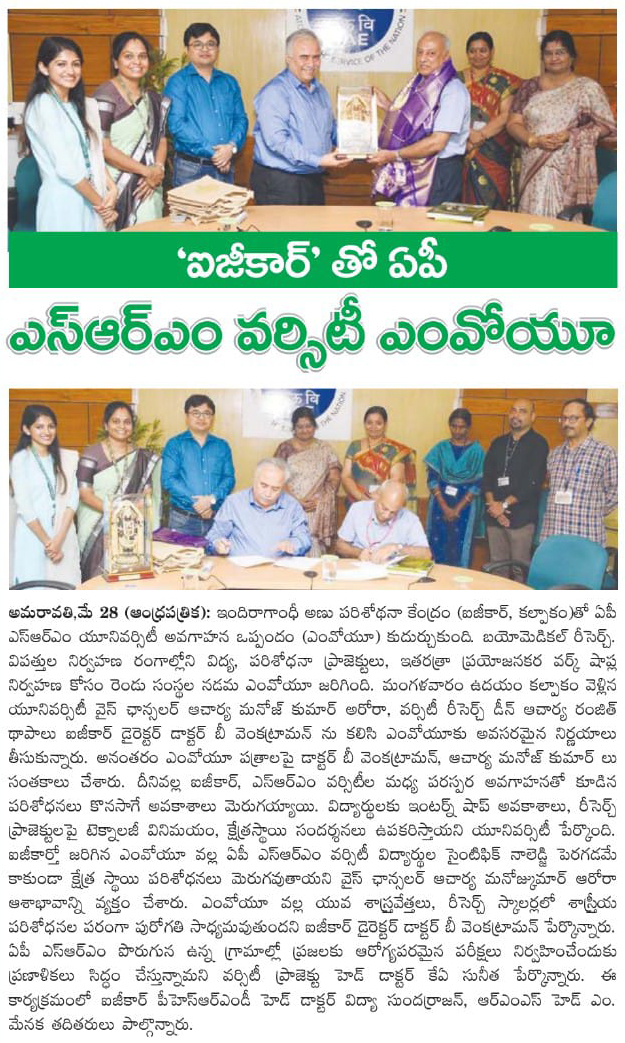
Andhra Prabha
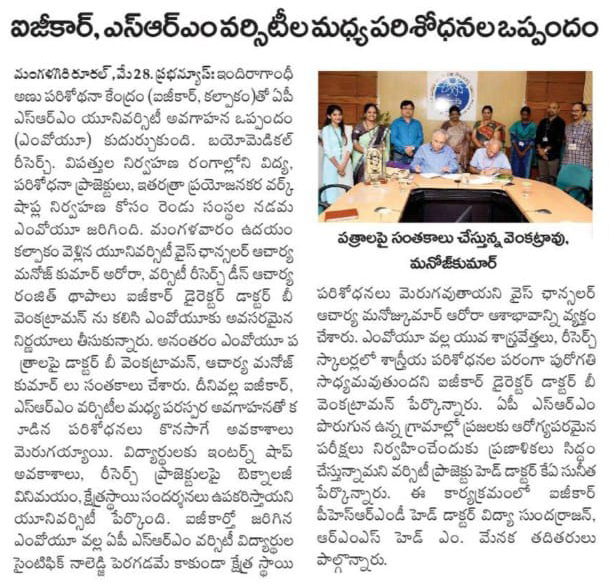
Sakshi
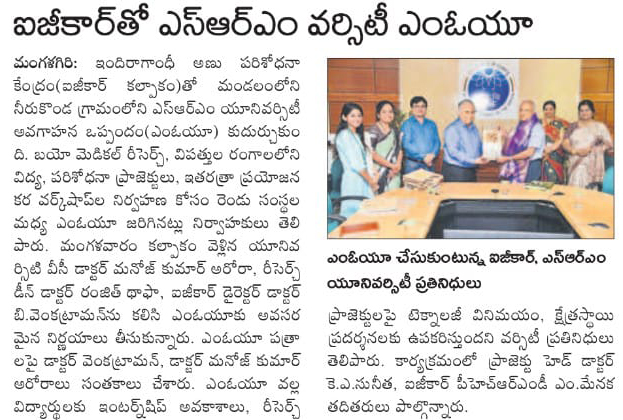
Telugu Patrika
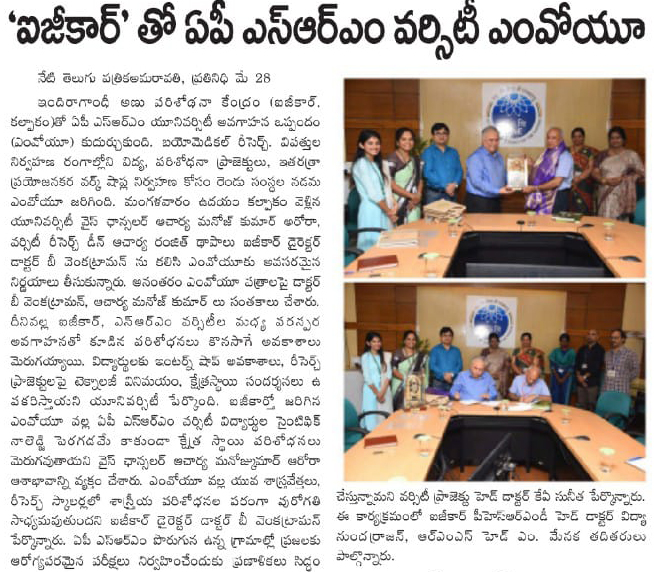
Vartha
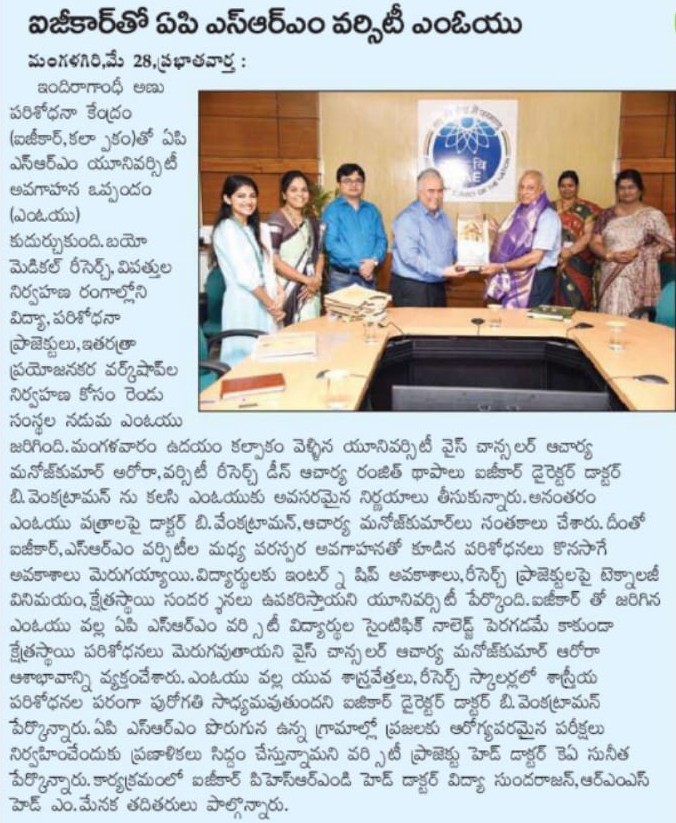
- MOU Signed with IGCAR for Cutting-edge Biomedical Research May 28, 2024
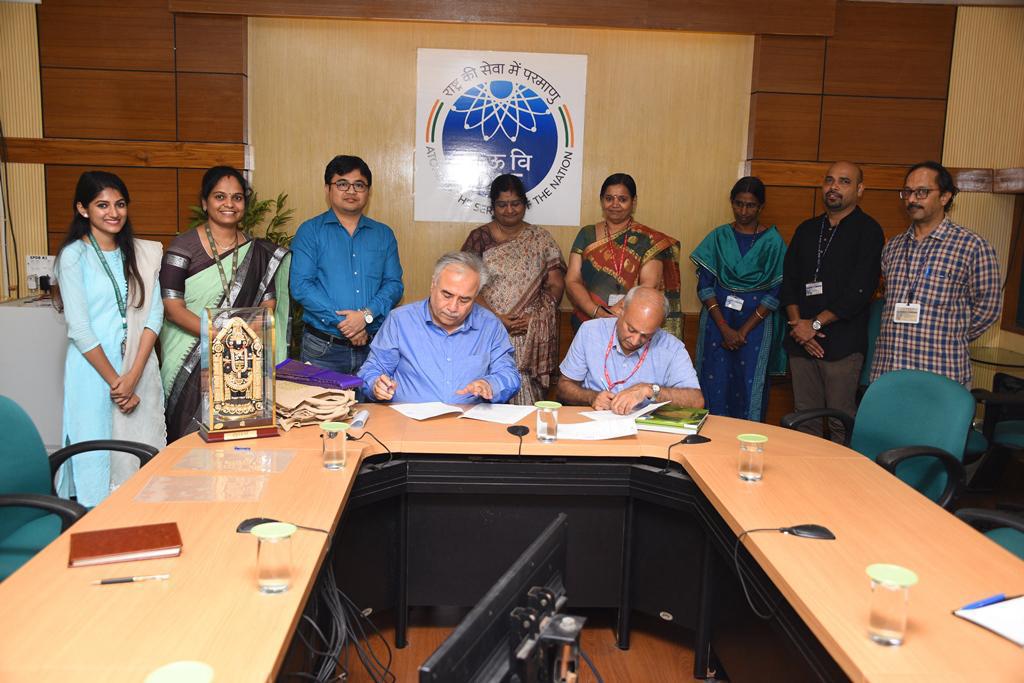
“This is a remarkable opportunity for our students to enhance their fields of study, gain academic insights from expert scientists and participate in cutting-edge research projects at IGCAR. This will ensure that we at SRM AP nurture students with a great scientific temperament,” stated Prof. Manoj K Arora, Vice Chancellor of SRM University-AP on signing the MOU with IGCAR.
SRM University-AP has signed a Memorandum of Understanding (MOU) with the Indira Gandhi Centre for Atomic Research (IGCAR) at Kalpakkam, Tamil Nadu, to collaborate on academic and research projects in Biomedical Research, Disaster Management, and other domains. The MOU was signed by Dr B Venkatraman, Director-IGCAR and Prof. Manoj K Arora, Vice Chancellor, SRM University-AP in the presence of Dr Vidya Sundarrajan, Head PHRMD & QAD, IGCAR Kalpakkam, Mrs M Menaka, Head RAMS, RESD, SQRMG, IGCAR, Kalpakkam, Prof. Ranjit Thapa, Dean-Research, SRM AP and Dr K A Sunitha, Associate Professor, SRM AP.
The MoU underscores a mutually beneficial agreement between the two institutes. On the academic front, the MOU provides internship opportunities, research collaboration for projects and industry visits for the students and faculty of SRM AP. This ensures a knowledge transfer between the two organisations, promoting stellar growth in scientific and technological advancements.
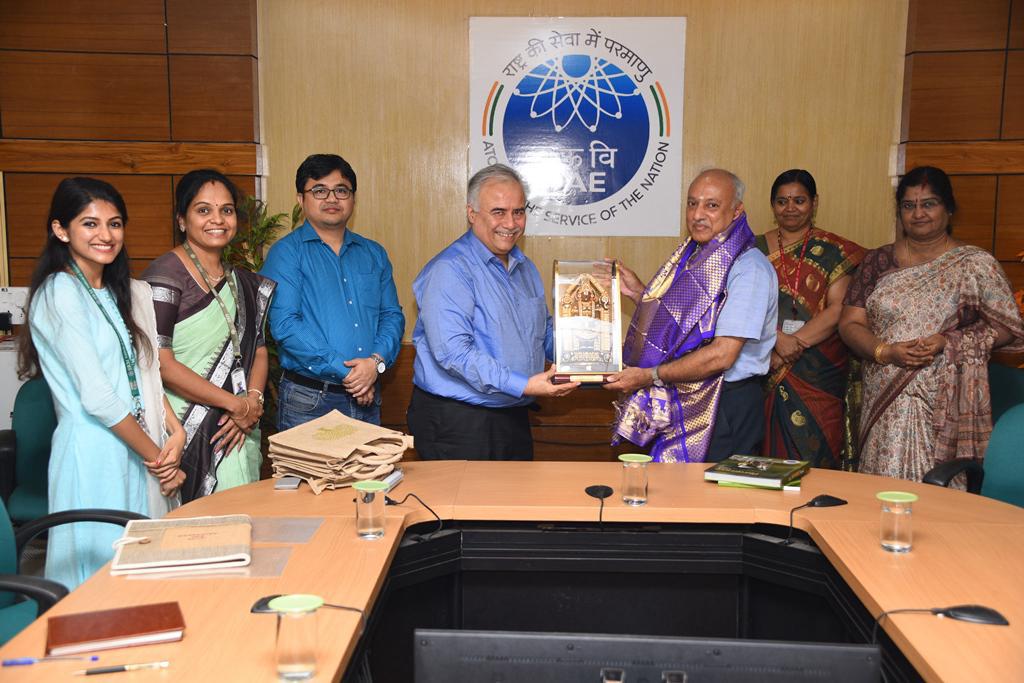
SRM AP has already collaborated with IGCAR on a consultancy project in the pioneering field of Biomedical Research last year. The parties have successfully conducted health screening of over 1500 subjects in the Chengalpattu region in Tamil Nadu, with SRM Medical Hospital & Research Centre and AIIMS Mangalagiri as secondary collaborators. Upon the successful completion of the project, IGCAR and SRM University-AP further extend their association with an official MOU for academic and research collaborations. “The MOU with SRM University-AP for translational research will be a huge motivation for the young faculty and scholars to pursue breakthrough research in their scientific domains,” remarked Dr B Venkatraman, Director-IGCAR.
Both institutes plan to extend their collaborative health screening project to the state of Andhra Pradesh, focusing on the neighbouring villages of SRM AP. Dr K A Sunitha, Project Head from SRM University-AP, opines that this project aims not just the possibility of translational research but also research for the societal cause. This research enables us to understand the correlated factors that influence various health disorders. Prof. Ranjit Thapa, Dean-Research also stated his enthusiasm for the project and expanding their research ventures to other domains.
Continue reading → - SRM University-AP Bids Farewell to the Graduating Batch of 2024 May 27, 2024
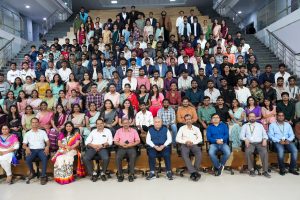 In a poignant and heartwarming event, The Directorate of Student Affairs at SRM University-AP bid adieu to its exceptional graduating batch of 2024. The farewell ceremony, held on the sprawling campus, was a celebration of achievements, camaraderie, and memories that will last a lifetime.
In a poignant and heartwarming event, The Directorate of Student Affairs at SRM University-AP bid adieu to its exceptional graduating batch of 2024. The farewell ceremony, held on the sprawling campus, was a celebration of achievements, camaraderie, and memories that will last a lifetime.The event celebrated the students’ academic journey and was marked by touching speeches delivered by deans and faculty members. The farewell ceremony was far more than a simple farewell. It transcended the mere act of bidding adieu to the graduating batch of 2024. Instead, it was a tapestry of emotions, a celebration of achievements, and a poignant moment that will linger in the hearts of all who were part of it. It incorporated various forms of artistic expression, including musical and dance performances by the juniors that added a vibrant and lively atmosphere to the occasion. Additionally, the ramp walk showcased the style and panache of the graduating students, highlighting their unique personalities.
Throughout the event, students were presented with accolades for their outstanding academic performance and exemplary leadership. As the sun set on the farewell ceremony, the Class of 2024 could be seen looking towards the future with hope and excitement. They carry with them not just degrees but also a legacy of excellence, resilience, and strong bonds of camaraderie forged during their time at SRM University-AP.
SRM University-AP expressed immense pride in its graduating students, who have demonstrated exceptional dedication and commitment to their education. The institution eagerly anticipates the future achievements of the Class of 2024.
Congratulations are in order for these bright minds as they embark on new adventures and endeavours. Here’s to a successful and fulfilling journey ahead for the Class of 2024!
Continue reading →


